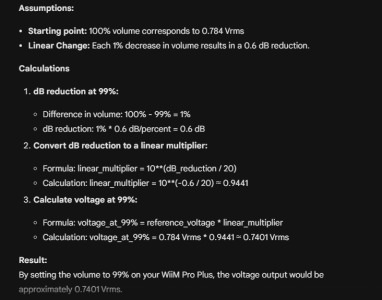I am curious. What is the reason for matching 0.75Vrms? By the way, this is the voltage when putting out full scale signal. Normal music will not be close to it.
Wiim has two volume controls. One is using the up/down button, which is disable if you set it to fixed volume output. The other is the volume limiter in %. According to this forum, every 5% is 3dB. So it you set it to 95%, it is -3dB and voltage is reduced by a factor 0.707. If you set it to 90%, it is -6dB and voltage is reduced to half.
I saw a measurement that at 0.8 v output at 100% volume, voltage is 0.784vrms
Taking that into consideration that 100% volume is 0.784vrms and knowing that each 1% volume change on volume limit (while having the volume fixed) represents 0.6 db I have asked gemini advanced and got the below:

The reason is compatibility in gain match with my amp high sensitivity setting . In general if you match input sensitivity with incoming voltage you get better synergy and sonic benefits.
Amp side:
High sensitivity input setting: around 0.75vrms
Mid: around 1.5vrms
High: around 3vrms
However if anyone has a multimeter it would be more accurate than this estimate.
Matching the output voltage of a DAC to the input sensitivity of your amplifier helps optimize your system's performance in several key ways:
Signal-to-Noise-Ratio (SNR):
Maximizing SNR: Matching output and input levels ensures the best possible signal-to-noise ratio. The DAC's signal will be strong relative to the inherent noise floor of your amplifier, leading to cleaner, more dynamic sound.
Avoiding Noise: If the DAC's output is too low, you'll need to crank the volume on your amp, potentially amplifying background noise along with the music.
Preventing Distortion (Clipping):
Headroom: If the DAC's output is too high for the amp's input sensitivity, you risk clipping. This means the tops and bottoms of audio waveforms get cut off, creating harsh distortion. Proper matching gives you more headroom to work with.
Clean Volume Changes: Properly matched levels give you finer control over volume changes. Too low a DAC output could mean big jumps between volume settings because you ride the upper end of the volume pot.
Utilizing the Volume Control:
Optimal Range: Correct matching lets you use a broader range of the volume knob on your amplifier. This typically aligns with the amp's most linear and best-sounding performance.
Avoiding Extremes: Using the volume knob at its very lowest settings can introduce noise; at extremely high volumes, you can stress and potentially damage components.


